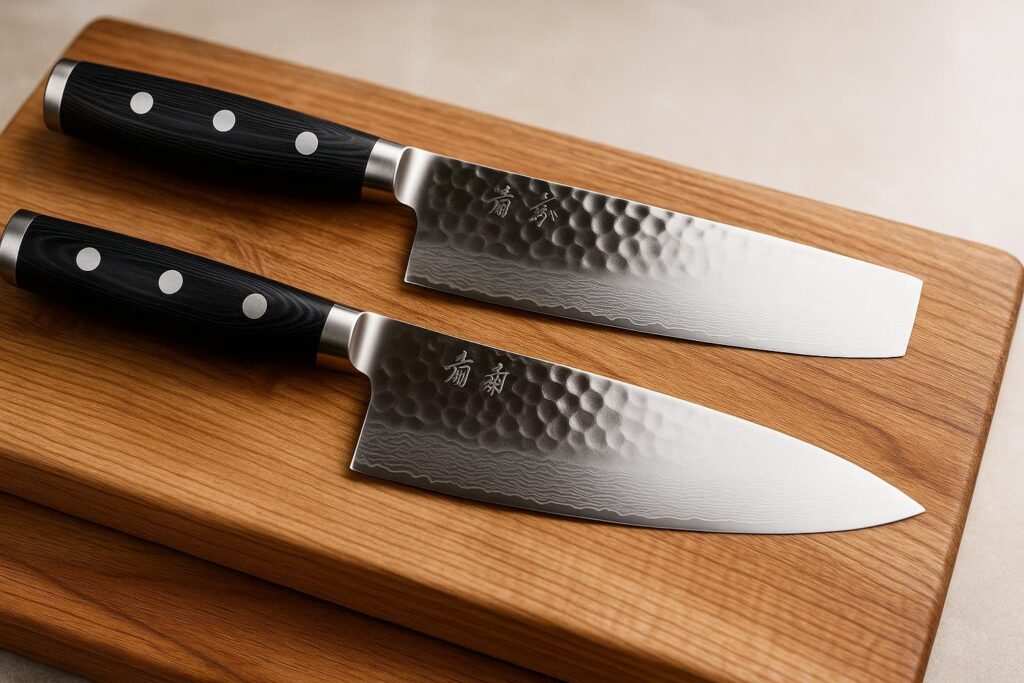
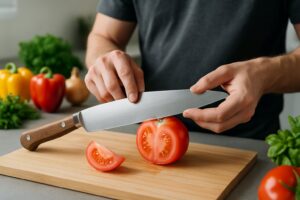

If you’re thinking about upgrading your kitchen tools, you might be asking yourself if a Nakiri Knife is better than a chef knife. A Nakiri shines when you are chopping vegetables. The Chef Knife is a jack-of-all-trades. The choice will depend on what you cook most often and how you like to prep your food.
A lot of home cooks love how fast and precise a Nakiri feels when slicing veggies. In contrast, the Chef Knife is the workhorse for cutting vegetables, meat, or whatever you throw at it.
A Nakiri knife is a traditional Japanese kitchen knife designed to slice, dice, and chop vegetables. Measuring 5–7 inches in length, the simple rectangular blade is sharp, thin, and requires little effort to get the job done.
Nakiris are usually double-beveled and there is no tip or belly. The straight edge on the Nakiri allows accurate chopping and push-cutting, and controlled fine cutting in the hand. There is plenty of room for your knuckles so they won’t get smashed as you chop your veggies. The wide blade also comes in handy for scooping food off the board.
Most Nakiris use Japanese steel or stainless steel. More expensive Nakiris have carbon steel blades for a sharper edge. The knife handles are often shaped for comfort, which you will appreciate during long chopping sessions.
If you need a knife that handles a wide range of foods and cutting styles, the western Chef Knife is a must have. This multipurpose kitchen knife has a 6 to 12 inch long curved blade for rocking motions. This is great for chopping, mincing, and dicing. The pointed tip helps separate and cut meat, veggies, and fine herbs
Many Chef Knives have ergonomic handles and textured grips for comfort and control. A good knife feels balanced and won’t tire your hand out quickly.
Chef knives are available come in Western and Japanese styles. The Gyuto is the Japanese version of a Western Chef Knife. The Gyuto blade is lighter and thinner.
| Feature | Nakiri Knife | Chef Knife |
|---|---|---|
| Blade Shape | Straight, rectangular | Curved, tapered |
| Blade Length | 5-7 inches | 6-12 inches |
| Edge Type | Straight edge | Curved edge |
| Bevel | Double bevel | Double or single bevel |
| Main Use | Vegetables | Multipurpose |
Nakiri and Chef knives each have their own strengths, depending on what you’re prepping. Their shapes, materials, and handle designs make them feel and cut differently in your hand.
The Nakiri gives you more control for those super-thin, precise veggie cuts. It’s also gentle and won’t squash delicate foods.
Chef knives are popular because they are adaptable. You can mince, slice, and chop. Go with a Chef Knife if you have a range of foods to prep for cooking.
Nakiris are often made with Japanese steel, either high-carbon or stainless steel. This blade material gives a sharp, thin edge perfect for slicing veggies. Chef knives might use Japanese steel for precision or German steel for extra durability.
High-carbon steel stays sharp longer but needs more care. It can rust if you’re not careful. Stainless steel is easier to keep up but might need sharpening more often. Some knives use layered (Damascus) steel for a mix of sharpness and toughness.
Steel and build quality matter. Better quality steel means your edge lasts longer.
Comfort and grip make a big difference. Nakiri handles are usually simple and straight, matching the knife’s light weight. They focus on easy control for fast, repetitive chopping.
Chef knife handles are often more shaped, fitting your hand better. Some add texture to keep your grip steady, especially when you’re working with slippery or wet foods.
Balance between blade and handle helps keep your hand from wearing out. If grip comfort is important, look for a handle that feels stable and fits your hand. Both Chef Knives and Nakiris can be comfortable and safe, depending on the design.
Nakiri and chef knives both stand out, but for different reasons. If you want to make your kitchen work easier, it’s worth knowing how each performs with veggies and other foods.
For chopping vegetables, the Nakiri is a true specialist. Its thin, flat, straight-edged blade is built for push cuts. You can slice through carrots, cucumbers, or leafy greens in one clean stroke. No rocking needed.
The wide blade helps keep food from sticking, and the flat tip lets you get those super-precise cuts. If you want uniform veggie slices or perfect julienne strips, the Nakiri is hard to beat. You can chop herbs quickly with a gentle up-and-down motion, no need to rock the blade.
Chef knives usually have a curved blade for a rocking motion, which is easier to use, especially for mincing garlic or onions. But getting perfectly even veggie slices can be trickier, since that curve changes your cutting angle. For strict vegetable prep, a Nakiri gives you more control and cleaner cuts.
Chef knives really shine when it comes to kitchen versatility. You’ll find yourself reaching for one to chop, slice, mince, and even tackle some light meat cutting. The sturdy, thick blade can handle breaking down big fruits or smashing garlic, no sweat.
Nakiris aren’t as flexible. They’re absolute champs at slicing veggies and making super clean cuts, but they fall short with bones or thick-skinned meats. The straight, delicate blade just isn’t built for hard foods or anything that needs much force.
If you want one knife to cover most kitchen tasks from prepping veggies to slicing some meats and herbs, a chef knife deserves a spot in your drawer. But if you’re into plant-based cooking or just love neat, lightning-fast veggie prep, the Nakiri makes a pretty compelling argument.
When it comes to slicing meat, chef knives usually take the cake. The thicker, curved blade gives you the heft and control you need for boneless meats and tougher cuts, and the rocking motion makes slicing, chopping, and mincing a breeze.
Nakiris are not designed for cutting meat. Their thin, straight blades can bend or chip if you try to cut through anything tough. Sure, you might use one to slice tofu or cooked meats, but it’s not the right pick for breaking down chickens or cutting steaks.
For folks who want one knife to do it all, the chef knife’s design lets you bounce between meats, veggies, and whatever else you’re cooking. The Nakiri stays in its lane. Its perfect for vegetable lovers who crave those clean, even slices.
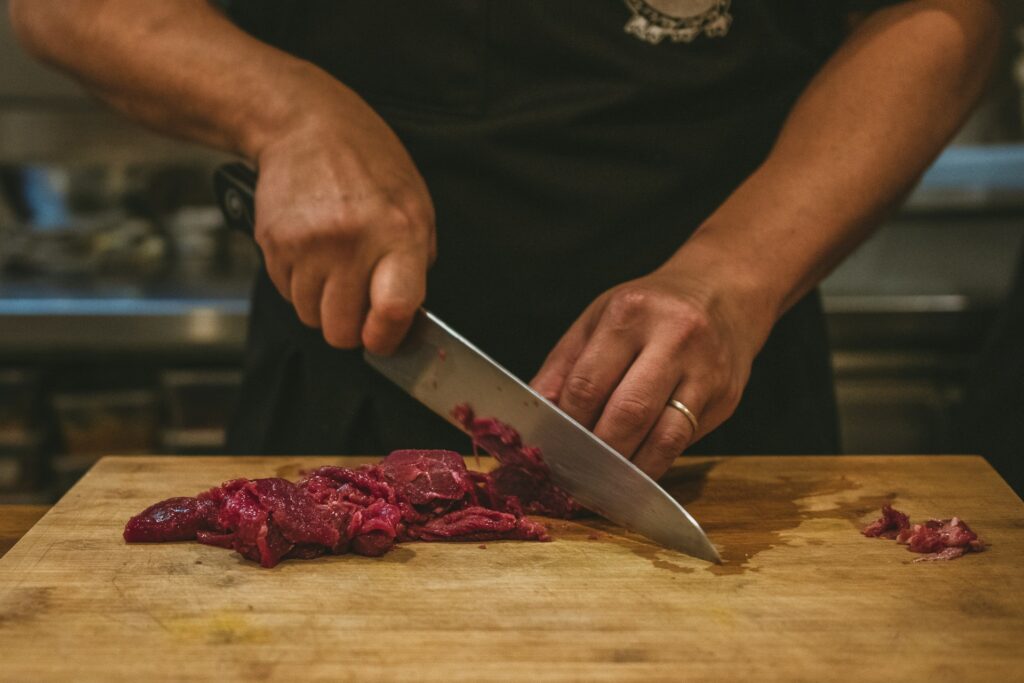
Both Nakiri and chef knives need regular care. Price, durability, and sharpening all play a part in which one might suit you best.
Nakiris usually come with a thinner, straight edge. That gives them razor-sharp precision on veggies, but the edge can dull quicker on hard foods. Most Nakiris use harder, high-carbon steel, so they hang onto their sharpness. But this means the Nakiri blade is more brittle and needs gentle handling.
Chef knives have a curved blade that’s easier to sharpen with a honing rod or whetstone. They’re more forgiving if you hit bone or something tough. Sharpening them is straightforward, and you can fix small chips or dull spots without much hassle. Both types do fine with whetstones, but if you’re always chopping dense veggies, you’ll probably sharpen your nakiri more often.
Nakiris can be cheaper than fancy chef knives, but prices jump around depending on steel and brand. Entry-level Nakiris give you solid value for veggie work. The high-end ones might use Damascus steel or hand-forging, which bumps up the cost.
Chef knives cover a bigger price range and tend to be more versatile. You’re paying for adaptability and toughness. If you want just one great knife, a chef knife usually brings better long-term value. For dedicated veggie prep, though, I’d go with a Nakiri for its precision and ease of use.
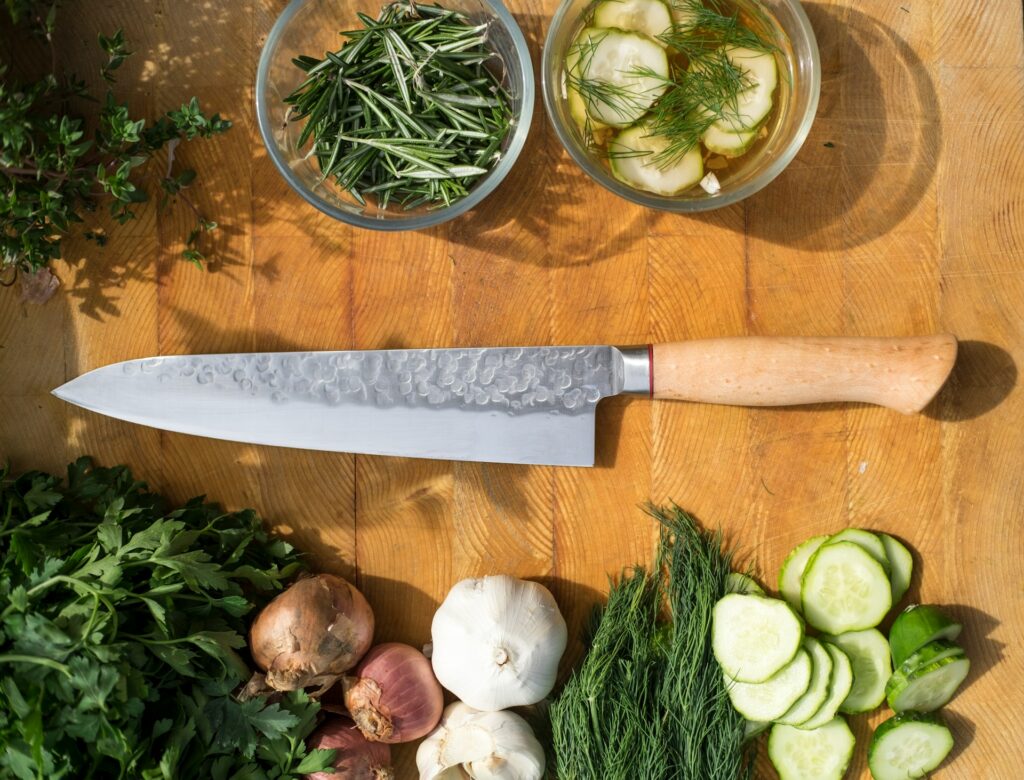
The Nakiri knife is built for efficient vegetable cutting, with a flat blade that makes straight chopping feel natural.
The Nakiri’s straight, thin blade is made to slice and chop veggies, giving you clean, precise cuts without needing to rock the knife. Chef’s knives have that classic curve, which helps with rocking motions and a broader range of kitchen duties, but they’re not quite as dialed in for vegetable work.
If you want to geek out on how the Nakiri shines in veggie prep, check out Choppn’ Knives or Made In.
Reach for a Santoku if you want a knife that can handle slicing, dicing, and mincing. It’s pretty versatile and works well for veggies, meat, and fish. The shorter, wider blade helps with quick, precise cuts, making it nice for smaller hands or cramped kitchens.
Nakiris just aren’t made for meat or bones. The thin, straight blade handles soft stuff, but it could bend or chip on dense foods. You can use it for boneless meats, but a chef’s knife or a dedicated meat knife will make your life easier for most meat prep.
A great Nakiri has a sharp, thin edge and a handle that feels balanced in your hand. Look for blades made from high-carbon or stainless steel. They last longer. The blade should be flat and rectangular, and the handle shouldn’t feel too heavy or too light. I’d also go for a textured grip if you want to avoid slipping mid-chop,
Chefs often reach for a Gyuto because it’s just so much more adaptable. While the Nakiri really shines with veggies, the Gyuto doesn’t stop there. It tackles meats, fish, and handles fine chopping without missing a beat. The blade’s curved edge lets you push-cut or rock the knife, enabling you to switch between different kitchen jobs and cutting styles to suit.
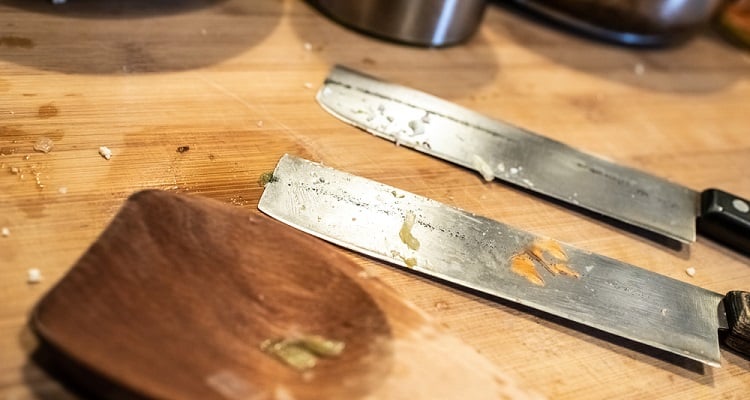
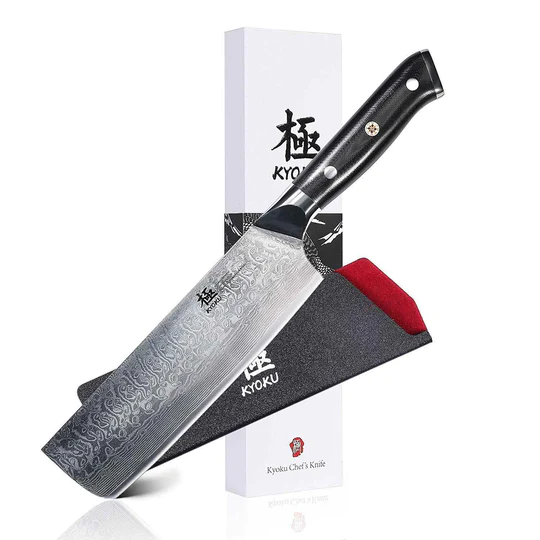
Knife Buzz offers independent product reviews on a wide range of knives used in the kitchen, home, and outdoors. We make it easy for you to find the right knife at the best price.